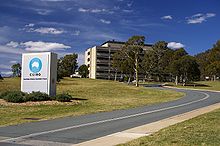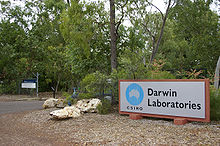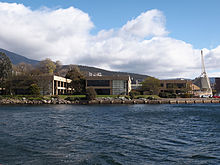- Commonwealth Scientific and Industrial Research Organisation
-
Commonwealth Scientific and Industrial Research Organisation 
Agency overview Formed 1926 Jurisdiction Commonwealth of Australia Headquarters Canberra, Australian Capital Territory, Australia Employees 6600+ Agency executive Megan Clark Website csiro.au The Commonwealth Scientific and Industrial Research Organisation (CSIRO) is the national government body for scientific research in Australia. It was founded in 1926 originally as the Advisory Council of Science and Industry.
Research highlights include the invention of atomic absorption spectroscopy, development of the first polymer banknote, the invention of Wi-Fi technology,[1] the invention of the insect repellent in Aerogard and the introduction of a series of biological controls into Australia, such as the introduction of Myxomatosis and Rabbit calicivirus which causes rabbit haemorrhagic disease for the control of rabbit populations. CSIRO's research into ICT technologies has resulted in advances such as the Panoptic Search Engine[2] (now known as Funnelback) and Annodex.[3]
In October 2005 the journal Nature announced that CSIRO scientists had developed near-perfect rubber from resilin, the elastic protein which gives fleas their jumping ability and helps insects fly.[4] On 19 August 2005, CSIRO and UTD (University of Texas at Dallas) announced they were able to make transparent carbon nanotube sheets that will bring carbon nanotube products to the masses.
Contents
Research groups and initiatives
Employing over 6,600 staff, CSIRO maintains more than 50 sites across Australia and biological control research stations in France and Mexico. The primary roles of CSIRO include contributing to meeting the objectives and responsibilities of the Australian Federal Government and providing new ways to benefit the Australian community and the economic and social performance of a number of industry sectors through research and development.
Research undertaken by CSIRO is divided into operational 'Divisions'. As at September 2010, these divisions are[5]:
- Astronomy and Space Science (including the Australia Telescope National Facility)
- Earth Science and Resource Engineering
- Energy Technology
- Food and Nutritional Sciences
- ICT Centre
- Land and Water
- Livestock Industries
- Marine and Atmospheric Research
- Materials Science and Engineering (including former Molecular and Health Technologies)
- Mathematics, Informatics and Statistics
- Process Science and Engineering
- Plant Industry
- Ecosystems Sciences (including Entomology)
In 2007, the divisions of Industrial Physics and Manufacturing and Materials Technology merged to form a new division, Materials Science and Engineering. On 1 July 2010, the Materials Science and Engineering division then merged with Molecular and Health Technologies to form a new division, also called Materials Science and Engineering, led by Dr Calum Drummond.
In addition, CSIRO is a participant in a number of joint ventures, including:
- Ensis — forestry and forest products, with New Zealand's Forestry research organisation named Scion
- Food Science Australia — with the Victorian Government (known as "CSIRO Division of Food and Nutritional Sciences" as of 1 July 2009[6])
- The Australian e-Health Research Centre — with the Queensland Government
"Flagship" initiative
The CSIRO "Flagship" initiative was designed to integrate, focus and direct national scientific resources. In May 2005, the government announced the launch of CSIRO's $97 million Flagship Collaboration Fund, which is intended to encourage cooperative research between universities, CSIRO and other research agencies.
As of Oct 2009[update], CSIRO supported the following 9 "Flagships"[7]:
- Climate Adaptation
- Energy Transformed
- Food Futures
- Light Metals
- Minerals Down Under
- Future Manufacturing
- Preventative Health
- Water for a Healthy Country
- Wealth from Oceans
- Sustainable Agriculture
In April 2007, funding for a new Flagship was announced by the Federal government.[8] It will be investigating the effects of Climate Change.
The Air Quality Modelling and Dispersion Team
CSIRO's Air Quality Modelling and Dispersion Team[9] is a part of the Marine and Atmospheric Research division.
Some of the widely used air quality dispersion models[10] developed by CSIRO are:
The "Australian Air Quality Forecasting System" is provided jointly by the Australian Bureau of Meteorology and CSIRO. The Bureau of Meteorology generates the high resolution weather forecasts and CSIRO has created computer models to calculate pollution levels.
History
A precursor to CSIRO, the Advisory Council of Science and Industry, was established in 1916 at the initiative of Prime Minister Billy Hughes. However, the Advisory Council struggled with insufficient funding during the First World War. In 1920 the Council was renamed the "Commonwealth Institute of Science and Industry", and was led by George Handley Knibbs (1921–26), but continued to struggle financially.
In 1926 The Science and Industry Research Act replaced the Institute with the 'Council for Scientific and Industrial Research' (CSIR). The CSIR was structured to represent the federal structure of Australian government, and had state-level committees and a central council. As well as this improved structure, the CSIR benefited from strong bureaucratic management under George Julius, David Rivett, and Arnold Richardson. CSIR research focussed on primary and secondary industries. Early in its existence, it established divisions studying animal health and animal nutrition. After the depression, the CSIR extended into secondary industries such as manufacturing.
CSIRO today has expanded into a wider range of scientific inquiry. This expansion began with the establishment of CSIRO in 1949 which, as well as a name change, reconstituted the organisation and its administrative structure. Under Ian Clunies Ross as chairman, CSIRO pursued new areas such as radioastronomy and industrial chemistry.
Notable Inventions
Notable inventions and breakthroughs by CSIRO include:
- A4 DSP chip
- Aerogard, insect repellent
- Atomic absorption spectroscopy
- Biological control of Salvinia
- Gene shears
- Development of Linola (a flax variety with low alpha-linolenic acid content) with a longer life used as a stockfeed
- Distance_measuring_equipment (DME) used for aviation navigation
- Parkes Radio Telescope
- Microwave landing system, a microwave approach and landing system for aircraft
- Polymer banknote
- Relenza flu drug
- 'Softly' woolens detergent
- X-ray phase contrast imaging
- Use of myxomatosis and calicivirus to control rabbit numbers
- The permanent pleat for fabrics
- Wi-Fi[1]
Historic research
CSIRO owned the first computer in Australia, CSIRAC, built as part of a project began in the Sydney Radiophysics Laboratory in 1947. The CSIR Mk 1 ran its first program in 1949, the fifth electronic computer in the world. It was over 1000 times faster than the mechanical calculators available at the time. It was decommissioned in 1955 and recommissioned in Melbourne as CSIRAC in 1956 as a general purpose computing machine used by over 700 projects until 1964.[16] The CSIRAC is the only surviving first-generation computer in the world.[17]
Between 1965 and 1985, Dr. George Bornemissza of CSIRO's Division of Entomology founded and led the Australian Dung Beetle Project. Dr. Bornemissza, upon settling in Australia from Hungary in 1951, noticed that the pastureland was covered in dry cattle dung pads which did not seem to be recycled into the soil and caused areas of rank pasture that was unpalatable to the cattle. He proposed that the reason for this was that native Australian dung beetles, which had co-evolved alongside the marsupials (which produce dung very different in its composition from cattle), were not adapted to utilise cattle dung for their nutrition and breeding, since cattle had only relatively recently been introduced to the continent in the 1880s. The Australian Dung Beetle Project therefore, sought to introduce species of dung beetle from South Africa and Europe (which had co-evolved alongside bovids) in order to improve the fertility and quality of cattle pastures. 23 species were successfully introduced throughout the duration of the project and also had the effect of reducing the pestilent bush fly population by 90%.[18].
Domain name
CSIRO was the first Australian organisation to start using the internet,[19] and as such was free to register the second-level domain csiro.au (as opposed to csiro.org.au or csiro.com.au). Guidelines were introduced in 1996 to regulate the use of the .au domain.
Chief Executives
Chief Executive Period in office Albert Rivett 1 January 1927 – 31 December 1945 Arnold Richardson 1 January 1946 – 18 April 1949 Frederick White 19 April 1949 – 13 December 1956 Stewart Bastow 1 January 1957 – 30 June 1959 No designated chief executive 1 July 1959 – 4 December 1986 Keith Boardman (acting) 5 December 1986 – 4 March 1987 Keith Boardman 5 March 1987 – 4 March 1990 John Stocker 5 March 1990 – 4 March 1995 Roy Green (acting) 5 March 1995 – 20 July 1995 Roy Green 21 July 1995 – 2 January 1996 Roy Green (acting) 3 January 1996 – 4 February 1996 Malcolm McIntosh 5 February 1996 – 7 February 2000 Colin Adam (acting) 7 February 2000 – 14 January 2001 Geoff Garrett 15 January 2001 – 31 December 2008 Megan Clark[20] January 2009 Recent controversies
Diet book
In 2005 the organisation also gained worldwide attention (and criticism) for publishing and promoting the Total Wellbeing Diet book[21] which features a high-protein, low-carbohydrate diet. The book has sold over half a million copies in Australia and over 100,000 overseas[22] but was criticised in an editorial by Nature for giving scientific credence to a "fashionable" diet book sponsored by meat and dairy industries.[23]
802.11 patent
CSIRO has consistently maintained that it owns the rights to a key part of modern IEEE 802.11 protocols with U.S. Patent 5,487,069. It declined to sign a Letter of Assurance that no lawsuits would be filed over its use in the 802.11n currently gaining acceptance.[24] In late November 2007, CSIRO won a lawsuit against Buffalo Technology, with an injunction that Buffalo must stop supplying AirStation products that infringe on the 802.11 patent.
On 19 September 2008, the Federal Circuit ruled in Buffalo’s favour and remanded the case to the district court ruling that the district court’s Summary Judgement was insufficient on the merits of obviousness of CSIRO’s patent. Therefore, this case was to be tried again before the district court. In this connection Buffalo was hopeful that it would shortly be permitted to, once again, sell IEEE 802.11a and 802.11g compliant products in the United States.[24][25] On 13 July 2009 Buffalo announced the settlement of the patent infringement action.[26]
As of 23 April 2009, the CSIRO has obtained settlements from most of the other organisations involved, including Dell, Intel, Microsoft, Asus, Fujitsu, Hewlett Packard, Nintendo, Toshiba, Netgear, D-Link, Belkin, SMC, Accton and 3Com.[27]
See also
- Australia Telescope National Facility
- Australian Animal Health Laboratory
- Australian Bird and Bat Banding Scheme
- Australian Dung Beetle Project
- Cooperative Research Centres (CRCs)
- CSIRO Marine and Atmospheric Research
- CSIRO Publishing
- Funnelback
- George Bornemissza
- Peter Rathjen
- Australian Space Research Institute
References
- ^ a b Sygall, David (2009-12-07). "How Australia's top scientist earned millions from Wi-Fi". Sydney Morning Herald. http://www.smh.com.au/technology/sci-tech/how-australias-top-scientist-earned-millions-from-wifi-20091207-kep4.html. Retrieved 2011-10-31.
- ^ Funnelback Home Page
- ^ CeNTIE Home Page
- ^ Elvin CM, Carr AG, Huson MG, Maxwell JM, Pearson RD, Vuocolo T, Liyou NE, Wong DC, Merritt DJ, Dixon NE (13 October 2005). "Synthesis and properties of crosslinked recombinant pro-resilin". Nature 437 (7061): 999–1002. doi:10.1038/nature04085. PMID 16222249. http://www.nature.com/nature/journal/v437/n7061/full/nature04085.html. Retrieved 2006-04-24.
- ^ "CSIRO Divisions". http://www.csiro.au/org/Divisions.html.
- ^ CSIRO FSA/CNFS web site
- ^ CSIRO Flagships website
- ^ CSIRO to help adapt to climate change (Media Release)
- ^ Air Quality Modelling and Dispersion Team
- ^ Beychok, M.R. (2005). Fundamentals Of Stack Gas Dispersion (4th ed.). self-published. ISBN 0-9644588-0-2. www.air-dispersion.com
- ^ TAPM documentation
- ^ LADM documentation
- ^ AUSPLUME brief summary (scroll down beneath slide)
- ^ AUSPUFF brief summary (scroll down beneath slide)
- ^ DISPMOD brief summary (scroll down beneath slide)
- ^ Steven Pass, David Hornsby. "CSIRAC". Department of Computer Science and Engineering. University of Melbourne. http://www.csse.unimelb.edu.au/dept/about/csirac/. Retrieved 2006-05-08.
- ^ "Museum Victoria's CSIRAC information site". http://www.museum.vic.gov.au/csirac/. Retrieved 2008-04-26.
- ^ Bornemissza, G. F. (1976), The Australian dung beetle project 1965-1975, Australian Meat Research Committee Review 30:1-30
- ^ "AARNET - About Us - History". Australian Academic and Research Network. http://www.aarnet.edu.au/about-us/history.aspx. Retrieved 16 April 2011.
- ^ Dr Megan Clark: Next Chief Executive of CSIRO
- ^ http://www.csiro.au/csiro/channel/pchaj,,.html Total Wellbeing Diet
- ^ "The town taking the CSIRO challenge". A Current Affair. 2005-12-06. Archived from the original on 2005-12-13. http://web.archive.org/web/20051213020826/http://aca.ninemsn.com.au/stories/2006.asp. Retrieved 2006-04-24.
- ^ "A recipe for trouble". Ergogenics. 8 January 2006. http://www.ergogenics.org/230.html. Retrieved 2006-04-24.
- ^ a b "Next generation Wi-Fi mired in patent fears". 21 September 2007. http://www.theregister.co.uk/2007/09/21/802_11n_patent_threat/. Retrieved 2007-09-21.
- ^ "Buffalo issues a statement about the CSIRO appeal". http://www.buffalotech.com/press/releases/buffalo-issues-a-statement-about-the-csiro-appeal/.
- ^ http://www.buffalotech.com/press/releases/buffalo-settles-infringement-action-by-csiro/
- ^ Nic MacBean. "CSIRO settles on wireless patent". ABC Science. http://www.abc.net.au/science/articles/2009/04/23/2550483.htm.
Bibliography
- Currie, George; Graham, John, The Origins of CSIRO: Science and the Commonwealth Government, 1901-1926, CSIRO, Melbourne, 1966
External links
- CSIRO Webpage
- History of CSIRO
- Commonwealth of Australia. Commonwealth Scientific and Industrial Research Organisation (CSIRO). (1949-) National Library of Australia, Trove, People and Organisation record for CSIRO
- Commonwealth of Australia. Council for Scientific and Industrial Research (CSIR). (1926-1949) National Library of Australia, Trove, People and Organisation record for CSIR
- Patent Suit
- CSIRO Publishing
- The Australian e-Health Research Centre
Public sector space agencies Africa North AfricaSub-SaharanAmericas North AmericaSouth AmericaAsia East AsiaSoutheast AsiaSouth AsiaSouthwest AsiaCentral AsiaEurope Oceania World Categories:- Scientific institutions
- Scientific organisations based in Australia
- Air dispersion modeling
- Commonwealth Government agencies of Australia
- Research institutes in Australia
Wikimedia Foundation. 2010.



